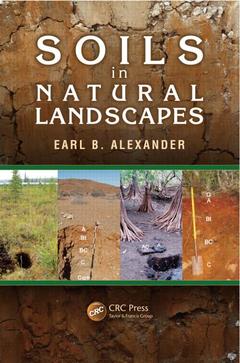Description
Soils in Natural Landscapes
Author: Alexander Earl B.
Language: English
Subjects for Soils in Natural Landscapes:
Keywords
Soil Survey; Vascular Plants; Ecological landscapes; Plant Detritus; Soil management; Argillic Horizons; Soil organisms; Parent Materials; Plant nutrients; Soil Taxonomy; Net primary productivity; STRs; Global cycles; Soil Organic Matter; Carbon cycle; Umbric Epipedons; Soil Survey Staff; Field Capacity; Soil Parent Materials; Base Saturation; Basic Cations; Soil Quality; Soil Survey Manual; Organic Detritus; C3 Pathway; C4 Pathway; Diagnostic Horizons; SMRs; Oa Horizons; Spodic Horizon; Soil Crusts; Ocean Crust
Approximative price 142.05 €
In Print (Delivery period: 15 days).
Add to cartSupport: Print on demand
Description
/li>Contents
/li>Biography
/li>
In any complete investigation of terrestrial ecosystems, rocks and soils must be considered. Soils are essential resources, providing water and nutrients for vascular plants, and mitigating the flow of water from the land. In addition, soil diversity is critical for biotic diversity. While there are many references on the agricultural perspective of soils, there is a need for a basic soils book for those concerned with natural landscapes and ecosystems. Soils in Natural Landscapes fills this niche, providing a thorough introduction to the physics, chemistry, and biology of soils and their roles in local to global systems.
The book begins by describing the field of soils and the major roles of soils in natural landscapes. The chapters that follow cover a range of topics:
- Soil parent material
- Architecture of soils
- Temperature and soils
- Water, air, and climate
- Classification of soils
- Soil landscapes
- Plant nutrition
- Soil organisms
- Organic matter in soils
The author also discusses global issues such as water and carbon cycles, global warming, and acid rain. He addresses land management for different uses, soil quality, and soil degradation. Using an interdisciplinary approach, this book provides practical insights for the evaluation of soils in natural environments and their non-intensive management.
Soils, Landscapes and Ecosystems. Soil Parent Material, Weathering, and Primary Particles. Soil Architecture—Structural Units and Horizons. Heat and Soil Temperature. Soil Water, Air, and Climate. Soil Classification—Kinds of Soils. Soils in Landscapes. Primary Production and Plant Nutrition. Soil Organisms: Life in Soils. Soil Organic Matter. Soils and Global Processes. Land Management and Soil Quality. Glossary. References. Appendices.
Earl B. Alexander is a retired pedologist, if you can call writing books (first author of Serpentine Geoecology of Western North America) and professional papers retirement. He has a Ph.D. in soils and has worked for the Soil Conservation Service (now NRCS), the California (now Pacific Southwest) Forest and Range Experiment Station, the Food and Agriculture Organization of the United Nations, the University of Nevada, and three regions of the U.S. Forest Service. He has mapped and investigated soils in Ohio, Nicaragua, Honduras, Costa Rica, Colombia, Nevada, California, Oregon, Alaska, and other states and provinces in western North America. He has developed interpretations for evaluating soil conditions and expected soil behaviours and made and reviewed recommendations for land management. More than 75 of his papers have been published in professional journals.
These books may interest you

Soil Formation 52.74 €



